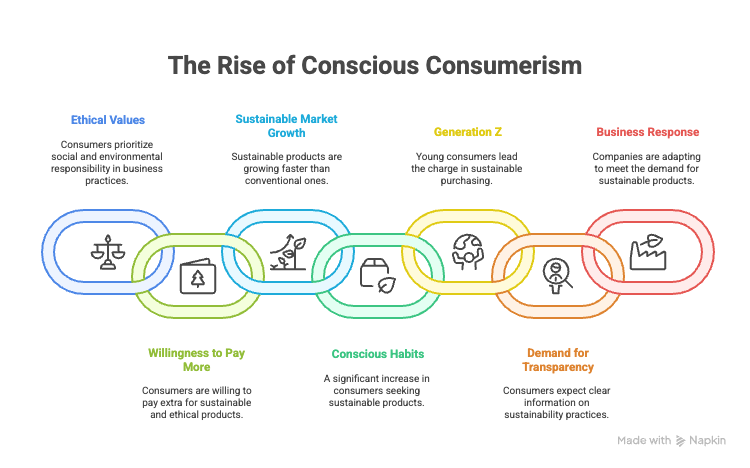Table of Contents
- Key Takeaways
- What Is Conscious Consumerism Anyway?
- The Conscious Consumer in Numbers
- Why Small Decisions Matter (More Than You Think)
- Everyday Shifts You Can Start With
- Looking Beyond the Label: Supply Chain Transparency
- How to Spot Truly Ethical Brands (and Avoid Greenwashing)
- Measuring Your Impact: Does Conscious Consumerism Really Work?
- FAQ about Conscious Consumerism
Conscious Consumerism: How Your Everyday Choices Shape a Better World
This page may contain affiliate links. We may earn a commission on purchases, at no additional cost to you. Learn more →
We buy something every few hours—food, clothes, detergents, digital downloads—yet rarely stop to ask “What (or who) did it cost to make this?” Those split-second habits quietly drain our wallets, expose our families to hidden toxins, and finance supply chains we might never consciously support. This article will explain conscious consumerism in layman's terms, making it easy to understand how your everyday purchases have a broader impact.
The result? Sensitive skin flares, overflowing rubbish bins, and a gnawing sense that our spending doesn’t match our values.
Good news: you don’t need a sustainability degree, unlimited budget, or zero-waste pantry to course-correct. Change begins with awareness, and even small steps can support a more thoughtful lifestyle. Conscious consumption is a growing trend that empowers individuals to make mindful choices, using their purchasing power to drive positive change. These are lifestyle choices that extend beyond purchases to include daily habits and mindset shifts that align with your values.
By mastering a few label-reading skills, favouring trusted certifications, and focusing on high-impact swaps, you can turn each purchase into a small yet mighty vote for health, ethics, and the planet. This guide shows you exactly how.

Image by Hanson Lu on Unsplash
Key Takeaways
-
Conscious consumerism means buying based on values—supporting people, the planet, and your own health.
-
Over 70% of Gen Z and Millennials now prefer sustainable brands—and the market is listening.
-
Small swaps—like switching to non-toxic cleaners or organic cotton—can drastically reduce your exposure to harmful toxins.
-
Consumers are demanding transparency: clear sourcing, ethical labor, and fewer buzzwords.
-
Every purchase is a vote. When millions shop mindfully, entire industries change.
What Is Conscious Consumerism Anyway?
Conscious consumerism – sometimes called ethical consumerism or conscientious consumerism – is the practice of making mindful, informed purchasing decisions that consider a product’s social, environmental, and ethical impacts.
The term surfaced in the late 1970s alongside fair‑trade coffee campaigns, exploded with the 1990s sweat‑shop exposés, and has matured in the 2020s into today’s data‑driven, app‑powered movement.
In essence, conscious consumers “vote with their dollars,” supporting companies that align with their values and avoiding those that harm people or the planet. This often means buying less overall, choosing durable, sustainable, high quality products, and favouring brands with fair labour practices and eco‑friendly materials that embrace innovative business models such as circular‑economy .
The movement is about looking beyond price and convenience – it’s about ensuring our shopping habits have a positive impact on workers, communities, and the environment. While product performance remains important, many consumers now prioritize ethical considerations and the broader effects of their purchases.
Conscious consumerism is important for promoting positive environmental impact, economic impact, and human rights. By making intentional choices, individuals can influence sustainable habits, ethical consumption, and drive social and environmental change.
In practical terms, this means an ordinary trip to the store now carries extra weight: consumers are increasingly asking Who made this?, What’s it made of?, and What happens to it after use? Such questions reflect an intentional, values-driven approach to consumption that is at the heart of conscious consumerism.
It’s not about perfection; it’s about direction. Think of it as Google Maps for your money: every euro, dollar, or pound nudges brands either toward or away from safer, fairer, greener practices.

The Conscious Consumer in Numbers
Conscious consumerism isn’t just a feel-good idea – data shows it’s on the rise and reshaping markets. Below are some compelling statistics and facts that highlight the momentum of this movement:
-
Majority Values Ethics: 9 in 10 consumers say it’s important for businesses to operate in a socially and environmentally responsible way. Shoppers are paying attention to corporate values like never before.
-
Willingness to Pay More: According to Nielsen research, 66% of global consumers (and 73% of Millennials) would pay more for products from socially and environmentally responsible companies.
-
Sustainable Market Growth: Products marketed as sustainable now account for roughly 17% of the market by value, and they grew 2.7× faster than their conventionally marketed counterparts.
-
Conscious Habits Skyrocketing: A 2023 survey of U.S. adults revealed that 62% “always or often” seek out sustainably-made products – a huge jump from just 27% in 2021. This suggests a rapid shift toward greener shopping habits in a short time.
-
Generation Z Leads the Charge: Young consumers are the most enthusiastic: 73% of Gen Z shoppers are willing to pay more for sustainable goods. Millennials aren’t far behind – about 67% say they’ve made significant lifestyle changes toward more sustainable living, higher than Gen X (62%) or Boomers (59%).
-
Demand for Transparency: Over 60% of Generation X and Baby Boomer consumers consider sustainability when choosing brands, not just the youth. Shoppers increasingly expect clear information – e.g. carbon footprints, fair trade certifications – and reward brands that provide it.
-
Business Response: Companies are racing to meet conscious consumer demand. More than 50% of corporate growth in consumer goods comes from sustainability-marketed products. Big brands from retail to beauty are launching eco-friendly lines, improving supply chains, and touting sustainability initiatives.

In short, consumer pressure is driving real change across industries. These statistics underscore that conscious consumerism is far from a fringe trend – it’s shifting mainstream behavior! The takeaway is clear: conscious consumers are a powerful force, and their individual purchase decisions, as well as collective purchase decisions, can drive more sustainable impact and sustainable impact across industries. Their influence on the market continues to accelerate in 2025.
Why Small Decisions Matter (More Than You Think)
We’re all creatures of habit. We grab the same dish soap, wear the same brand of leggings, and pick up dinner from the same shelf. But those everyday choices? They carry real weight.
-
Body burden: . Looking at natural fiber clothing as an example, synthetic fabrics often shed micro-plastics and carry residues of formaldehyde or azo dyes that affect sensitive skin. The same applies to home cleaning products or skincare: A popular skincare cream might list phthalates and parabens—linked to hormone disruption and allergies. Less toxic ingredients mean less exposure to harmful substances.
-
Climate load: According to the UN, fashion alone generates up to 10 % of global carbon emissions. Swapping to organic cotton cuts water use by as much as 91 %.
-
Fast fashion pieces can contribute to unfair labor practices and landfill waste.
On the flip side, choosing organic cotton, a Fair Trade brand, or a non-toxic cleaner isn’t just a healthier decision—it’s a vote. You’re showing the world (and brands) that ethics, health, and sustainability matter.
No single purchase fixes these issues, yet every mindful swap chips away at them. The cumulative effect is massive. The goal isn’t about perfection, but about consistency.
“Every time you spend money, you’re casting a vote for the kind of world you want.” – Anna Lappé
When one person makes sustainable choices, others may follow suit, amplifying the positive impact across communities.

Everyday Shifts You Can Start With
Adjusting shopping habits doesn’t need to be expensive or overwhelming. Start with categories that affect you daily, like food, personal care or clothing. Once it becomes routine, expanding to other product categories feels more natural. Research ingredients, materials and manufacturing methods. Choose companies that disclose their processes and avoid greenwashing. Look for ethical products to support sustainable and responsible consumer choices. Supporting small businesses also benefits local economies and helps build stronger communities. While individual choices matter, government regulation is also essential for ensuring companies meet baseline standards for environmental and social responsibility.
Try These First Steps:
-
Swap one item: Replace your go-to body lotion with one that’s fragrance-free and EWG-verified.
-
Buy in bulk: Reduces packaging waste and saves money.
-
Research labels: Look for certifications like GOTS, Fair Trade, USDA Organic, or B Corp.
-
Support slow fashion: Choose timeless, quality clothing you’ll wear 50+ times.
-
Reuse: Refillable soap bottles, beeswax wraps, glass storage jars—they all help.
-
Digitise receipts & labels: Most checkout slips are printed on thermal paper coated with BPA or BPS—endocrine-disrupting chemicals that rub straight onto your skin. Skip the toxic paper by asking for an e-receipt or snapping a photo and recycling the original. Store the slips, eco-label, and warranty in one cloud folder so they’re searchable in seconds. If you ever need to fix document issues, an intuitive online document editor lets you tweak the file on the fly. Less BPA, less clutter, more peace of mind.

5 Ingredients To Watch Out For
-
Parabens – Found in cosmetics, linked to hormone disruption
-
Phthalates – Common in plastics and fragrance, harmful to reproductive health
-
PFAS – “Forever chemicals” in clothing and cookware
-
Formaldehyde – In furniture and clothing, classified as a carcinogen
-
BPA – In can linings and receipts, tied to endocrine issues
Your Wardrobe: Choose Skin-Safe Staples
-
Organic cotton basics, ditch toxic pesticides and feel buttery-soft on sensitive skin.
-
Certifications to trust: GOTS, OEKO-TEX® 100, Fairtrade Cotton.
-
Pro tip: Use the cost-per-wear formula: divide price by expected wears. Suddenly that €29 organic tee worn 100 times trumps a €10 fast-fashion tee worn twice
Personal Care: Ingredients First, Hype Later
-
Avoid: parabens, phthalates, synthetic fragrance, formaldehyde donors.
-
Swap to: oil-based cleansers, mineral sunscreens, and stem-cell or peptide serums from small-batch, third-party-tested brands.
-
Label hack: If “fragrance” is listed without an asterisk explaining the plant source, move on.
Home Cleaning & Laundry: Breathe Easy
-
Problem: Many surfactants release VOCs that linger indoors.
-
Quick wins: Concentrated refills, soap nuts, or fragrance-free powders in cardboard.
-
DIY Lemon-Vinegar Spray: Mix equal parts vinegar and water, add citrus peels, infuse one week—done.
Food & Drink: Everyday Fuel, Everyday Impact
-
Local & seasonal first: Fewer food miles = lower carbon footprint.
-
Bulk bins + reusable bags: Slash packaging waste.
-
Organic “Dirty Dozen”: If budget is tight, prioritise organic for produce with the highest pesticide load (strawberries, spinach, grapes, etc.).

Looking Beyond the Label: Supply Chain Transparency
For conscious consumers, the story doesn’t end at the product label. Today’s more conscious consumer wants to know not just what’s in a product, but how it got to the shelf. This means digging deeper into the supply chain—asking questions about where raw materials come from, how workers are treated, and what environmental standards are followed at every step.
Why does this matter? Because a company’s supply chain can reveal hidden environmental and social impacts that aren’t obvious from packaging alone. For example, the fashion industry has long struggled with issues like unsafe working conditions and pollution in textile factories. As a result, consumer demand for ethical sourcing and sustainable products is pushing companies to adopt more transparent and responsible business practices.
When making purchasing decisions, look for brands that openly share information about their supply chain, such as sourcing policies, factory locations, and third-party audits.
How to Spot Truly Ethical Brands (and Avoid Greenwashing)
Not every “eco-friendly” label is honest. That’s where greenwashing comes in—when companies exaggerate or lie about how sustainable they are.
Here’s how to stay sharp:
-
Look for third-party certifications
GOTS (Global Organic Textile Standard), OEKO-TEX, USDA Organic, Leaping Bunny, and Fair Trade are trustworthy signs. -
Beware of vague buzzwords
“Natural,” “green,” “clean” mean nothing without proof. Always check the full ingredients list or material breakdown. -
Check the supply chain
Is the brand transparent about where and how their products are made? Do they list their factories or sourcing policies?
💡 Pro tip: Use platforms like Good On You, Ethical Consumer, or B Corp Directory to research a brand's impact.
Choosing these kinds of products isn’t only about environmental benefits. It can also mean higher quality, safer ingredients and more durable design. Ethical brands tend to use fewer synthetic chemicals and often test their products to higher standards, which supports healthier low tox living as well.
How to Make Conscious Shopping a Long-Term Habit
Sustainability thrives when it becomes second nature. This happens through repetition, structure and occasional reflection. If a product turns out to be a strong choice, whether for ethics, durability or safety, note it. Stick to brands that prove their value and stay informed when they change suppliers or practices.
Avoid getting caught in a cycle of research fatigue. You don’t need to verify every detail every time. Build a shortlist of trusted sources, use comparison platforms or rely on communities that track ethical ratings.
Balance is key. Conscious shopping doesn’t require extremes. It’s about considering trade-offs, doing the best you can with available resources and staying open to learning.
Some people set budgets for sustainable products or schedule regular check-ins to review spending. Others keep it simple and focus on one product category at a time. Whatever method works for your routine is enough, as long as it stays consistent.
Small changes can build a lifestyle rooted in integrity, health and long-term satisfaction. Progress over perfection is a reasonable goal, the most likely to stick.
Measuring Your Impact: Does Conscious Consumerism Really Work?
It’s natural to wonder if your individual choices as a conscious consumer can truly make a difference. The answer is a resounding yes—especially when those choices are multiplied by millions of others. Consumer demand has already driven major shifts in industries ranging from food to transportation. For example, the surge in electric vehicle sales is a direct response to consumers seeking sustainable options, which has pushed companies to innovate and reduce their environmental footprint.
Businesses like Patagonia and REI have shown that prioritizing sustainability and social responsibility can lead to both positive social and environmental impacts—and commercial success. When consumers consistently choose sustainable products and support companies with strong ethical practices, they send a clear message that responsible business matters.
Research tools like google searches make it easier than ever to investigate a company’s claims and track their progress. As noted by an associate professor at Boston University, conscious consumerism is a crucial step toward achieving broader sustainability goals. By making informed purchasing decisions, consumers can push companies to adopt better practices, reduce environmental impacts, and create a real difference in the world.
Ultimately, while no single purchase will solve the climate crisis or end unfair labor practices, the collective power of conscious consumers can drive meaningful change. Every thoughtful purchase is a vote for a more sustainable, equitable future.

FAQ about Conscious Consumerism
To further clarify the concept, here are real questions people commonly ask about conscious consumerism, along with concise answers based on factual information and expert insights:
What is conscious consumerism?
Conscious consumerism is the practice of shopping mindfully – making purchasing decisions based on a product’s impact on society and the environment, not just price or convenience. It means considering the entire lifecycle of what you buy (how it’s made, who made it, and what happens after use) and choosing options that align with your values. In short, a “conscious consumer” tries to buy less overall, and when they do buy, they support ethical, sustainable brands.
What are some examples of conscious consumerism?
Examples include everyday choices and bigger buying decisions: purchasing green or cruelty-free products (like eco-friendly cleaning supplies or cosmetics not tested on animals), choosing an electric or hybrid car over a gas guzzler, shopping from companies known for fair wages, and boycotting fast-fashion brands with poor labor conditions. For instance, a conscious consumer might buy fair-trade coffee and organic foods to ensure farmers are paid fairly and fewer pesticides are used. They may use reusable items (water bottles, grocery bags) instead of disposables, and favor clothes made from sustainable materials (like bamboo or recycled fabric).
Is conscious consumerism the same as ethical consumerism?
Yes – the terms “conscious consumerism,” “ethical consumerism,” and even “green consumerism” are often used interchangeably. All refer to the idea of consumers making purchases based on ethics and values. There might be slight nuances (some people use ethical consumerism broadly for social/animal welfare issues and green consumerism specifically for environmental issues), but in practice they overlap heavily. The core principle is the same: mindful, responsible consumption. So if you hear any of those phrases, they’re generally talking about the same movement – using your purchasing power to support good practices and avoid harmful ones.
Header Image by Sinitta Leunen on Unsplash













